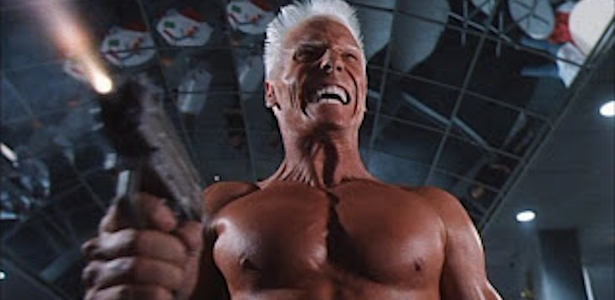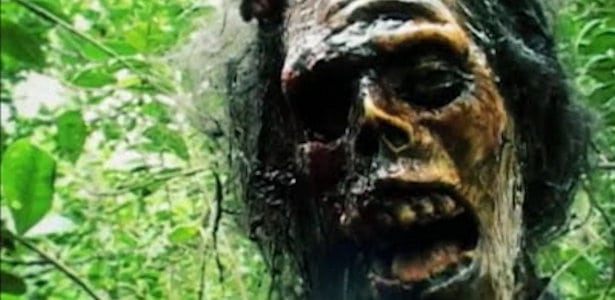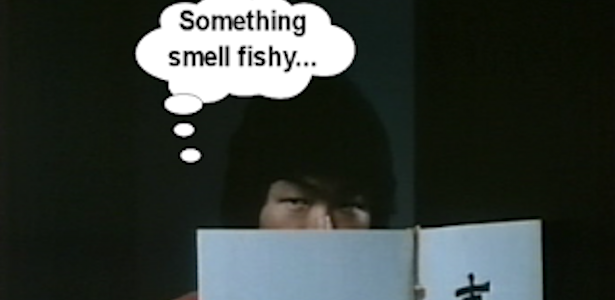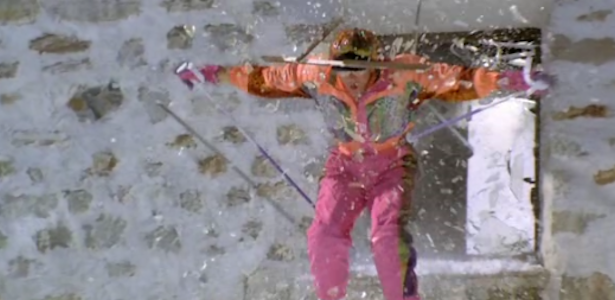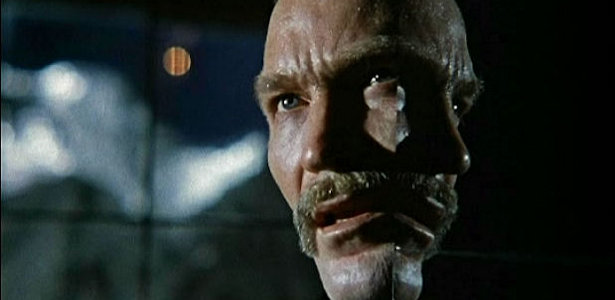We love us some regional exploitation flicks here at Video Junkie, especially if they came out in the ‘70s and ‘80s. There is something so damn endearing about folks outside of Hollywood trying to emulate big blockbusters (and the films are bereft of the wink-wink-nod-nod self referential “we’re intentionally making a bad movie” stuff you see in 99.9999998% of regional stuff today). One of the hotbeds during that era was my downstairs neighbor, North Carolina. Businessman Earl Owensby set about trying to create a Hollywood of the East in Shelby, North Carolina and I’d like to think his success pushed director Jet Eller to make MARLEY’S REVENGE: THE MONSTER MOVIE (1989).
The film opens with two cocaine smugglers on the run from a couple of good ol’ boys definitely meaning some harm. Apparently they took Nancy Reagan’s “Just Say No” program to its logical end and kill anyone dealing drugs in their neck of the woods. You know they are serious because one guy sports a Blue Oyster Cult t-shirt. Such vigilantism is soon to be bad news for pals Alan (Donnie Broom) and Gary (Alvin Johnson). These roommates are planning to smuggle Gary’s aunt and uncle in from Haiti. Now last time I checked going from Haiti to North Carolina is kinda roundabouts for human smuggling, but whatever. Alan and Gary are good guys, as evidenced by the TRANCERS (1984) poster on their wall. Well, Alan might be a bit of a tool as he is obsessed with a comic book character named Africa Dan.
Anyway, with $6,000 bucks and a CB radio, the boys are able to facilitate this illegal immigration. Unfortunately for them, our local vigilantes are listening on the CB and when they hear dollars and delivery point they just assume it is another cocaine deal that they must blow up. Our leads show up at the first rendezvous point, Mr. Ed’s Lounge (no talking horse in sight), and meet up with their contact, who looks like Kurt Russell in THE THING (1982).
Also sticking their nose into this business are the local sheriff and the local newspaper reporter. Yep, lot o’ locals in this place. The redneck vigilante group follows our two guys to the second rendezvous point and, naturally, takes them hostage. But not before they show them the dead Kurt Russell look-a-like to show they mean business. Everyone travels by boat to the island drop off point where the bumbling vigilantes – who are being assisted by the sheriff, whose family was apparently killed by drug dealers – find out these guys aren’t coke dealers after all. So how do they attempt to get out of this mess? Eh, just kill everyone and bury them. Hey, you can’t expect genius in a group where someone is nicknamed Tater. When the aunt is shot in the head, Uncle Marley resorts to some of his Haitian voodoo to bring forth his titular revenge. Not only does he cause the dozens of buried victims to rise from their graves, but he summons up some 14-foot tall alligator-skeleton looking thing. This is even more bad news for innocent Alan and Gary as the living dead gut munchers don’t know good from bad. If only Alan idolized some comic book hero who could show him the way to survive.
MARLEY’S REVENGE was a total video roulette grab for me and was a bit of a surprise. Any film that has rednecks dealing death within the first two minutes is going to get my attention. Throw in TRANCERS (1984) and I WAS A TEENAGE ZOMBIE (1987) posters and I’m emailing Tom within seconds saying, “Score!” Note to self: I should always watch at least fifteen minutes before declaring something as worthy of  praise. Truth be told, this flick plays like two different films mashed together. Writer-director Jet Eller (props for the awesome name alone) spends the first fifty or so minutes doing a reaaaaaaaaaaaally long set up for something could be realized in ten minutes. Once the film gets to the island though and the zombies pop up, the film is actually kind of fun. Sure, it has that same kind of logic your home movies that you shot as a teen had (for example, the reporter is only in the equation to show up with an extra boat before he is killed), but the two leads give their all when they have to run through the woods dodging zombies and monsters. The big monster is actually kind of cool looking too, an effectively realized prop for a low budget horror movie. The film also works as a great time capsule of ‘80s North Carolina, effectively capturing it as I remember it. Well, except I never got to hang out in Mr. Ed’s Lounge. If you can make it through the first fifty minutes, there is a little fun to be had in MARLEY’S REVENGE. And a little fun is all we really need nowadays.
praise. Truth be told, this flick plays like two different films mashed together. Writer-director Jet Eller (props for the awesome name alone) spends the first fifty or so minutes doing a reaaaaaaaaaaaally long set up for something could be realized in ten minutes. Once the film gets to the island though and the zombies pop up, the film is actually kind of fun. Sure, it has that same kind of logic your home movies that you shot as a teen had (for example, the reporter is only in the equation to show up with an extra boat before he is killed), but the two leads give their all when they have to run through the woods dodging zombies and monsters. The big monster is actually kind of cool looking too, an effectively realized prop for a low budget horror movie. The film also works as a great time capsule of ‘80s North Carolina, effectively capturing it as I remember it. Well, except I never got to hang out in Mr. Ed’s Lounge. If you can make it through the first fifty minutes, there is a little fun to be had in MARLEY’S REVENGE. And a little fun is all we really need nowadays.
The film opens with two cocaine smugglers on the run from a couple of good ol’ boys definitely meaning some harm. Apparently they took Nancy Reagan’s “Just Say No” program to its logical end and kill anyone dealing drugs in their neck of the woods. You know they are serious because one guy sports a Blue Oyster Cult t-shirt. Such vigilantism is soon to be bad news for pals Alan (Donnie Broom) and Gary (Alvin Johnson). These roommates are planning to smuggle Gary’s aunt and uncle in from Haiti. Now last time I checked going from Haiti to North Carolina is kinda roundabouts for human smuggling, but whatever. Alan and Gary are good guys, as evidenced by the TRANCERS (1984) poster on their wall. Well, Alan might be a bit of a tool as he is obsessed with a comic book character named Africa Dan.
Anyway, with $6,000 bucks and a CB radio, the boys are able to facilitate this illegal immigration. Unfortunately for them, our local vigilantes are listening on the CB and when they hear dollars and delivery point they just assume it is another cocaine deal that they must blow up. Our leads show up at the first rendezvous point, Mr. Ed’s Lounge (no talking horse in sight), and meet up with their contact, who looks like Kurt Russell in THE THING (1982).
Also sticking their nose into this business are the local sheriff and the local newspaper reporter. Yep, lot o’ locals in this place. The redneck vigilante group follows our two guys to the second rendezvous point and, naturally, takes them hostage. But not before they show them the dead Kurt Russell look-a-like to show they mean business. Everyone travels by boat to the island drop off point where the bumbling vigilantes – who are being assisted by the sheriff, whose family was apparently killed by drug dealers – find out these guys aren’t coke dealers after all. So how do they attempt to get out of this mess? Eh, just kill everyone and bury them. Hey, you can’t expect genius in a group where someone is nicknamed Tater. When the aunt is shot in the head, Uncle Marley resorts to some of his Haitian voodoo to bring forth his titular revenge. Not only does he cause the dozens of buried victims to rise from their graves, but he summons up some 14-foot tall alligator-skeleton looking thing. This is even more bad news for innocent Alan and Gary as the living dead gut munchers don’t know good from bad. If only Alan idolized some comic book hero who could show him the way to survive.
 praise. Truth be told, this flick plays like two different films mashed together. Writer-director Jet Eller (props for the awesome name alone) spends the first fifty or so minutes doing a reaaaaaaaaaaaally long set up for something could be realized in ten minutes. Once the film gets to the island though and the zombies pop up, the film is actually kind of fun. Sure, it has that same kind of logic your home movies that you shot as a teen had (for example, the reporter is only in the equation to show up with an extra boat before he is killed), but the two leads give their all when they have to run through the woods dodging zombies and monsters. The big monster is actually kind of cool looking too, an effectively realized prop for a low budget horror movie. The film also works as a great time capsule of ‘80s North Carolina, effectively capturing it as I remember it. Well, except I never got to hang out in Mr. Ed’s Lounge. If you can make it through the first fifty minutes, there is a little fun to be had in MARLEY’S REVENGE. And a little fun is all we really need nowadays.
praise. Truth be told, this flick plays like two different films mashed together. Writer-director Jet Eller (props for the awesome name alone) spends the first fifty or so minutes doing a reaaaaaaaaaaaally long set up for something could be realized in ten minutes. Once the film gets to the island though and the zombies pop up, the film is actually kind of fun. Sure, it has that same kind of logic your home movies that you shot as a teen had (for example, the reporter is only in the equation to show up with an extra boat before he is killed), but the two leads give their all when they have to run through the woods dodging zombies and monsters. The big monster is actually kind of cool looking too, an effectively realized prop for a low budget horror movie. The film also works as a great time capsule of ‘80s North Carolina, effectively capturing it as I remember it. Well, except I never got to hang out in Mr. Ed’s Lounge. If you can make it through the first fifty minutes, there is a little fun to be had in MARLEY’S REVENGE. And a little fun is all we really need nowadays. 



